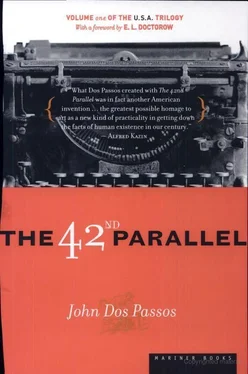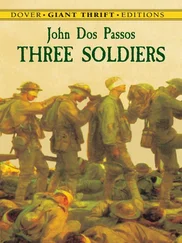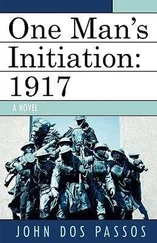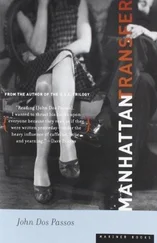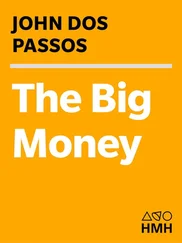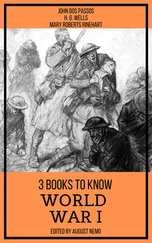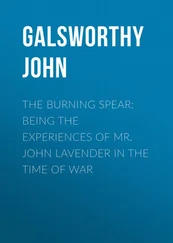“Do you mind traveling, Miss Williams?”
“I’ve never traveled, but I’m sure I’d like it.”
“I may have to take a small office force down with me… oil business. Let you know in a day or two…
“James Frunze c/o J. Ward Moorehouse
“100 Fifth Avenue New York
“Advise me immediately shoreham development situation A and B Barrow restless release statement on unity of interest americanism versus foreign socialistic rubbish. JWM…
“Thank you; that’ll be all today. When you’ve typed those out and sent the wires you may go.”
J. Ward Moorehouse went through a door in the back, taking his coat off as he went. When Janey had typed the articles and was slipping out of the hotel lobby to send the wires at the Western Union she caught a glimpse of him in a dress suit with a gray felt hat on and a buffcolored overcoat over his arm. He was hurrying into a taxi and didn’t see her. It was very late when she went home. Her cheeks were flushed but she didn’t feel tired. Alice was sitting up reading on the edge of the bed. “Oh, I was so worried…” she began, but Janey threw her arms round her and told her she had a job as private secretary to J. Ward Moorehouse and that she was going to Mexico. Alice burst out crying, but Janey was feeling so happy she couldn’t stop to notice it but went on to tell her everything about the afternoon at the Shoreham.
Edison was born in Milan, Ohio, in eighteen fortyseven;
Milan was a little town on the Huron River that for a while was the wheatshipping port for the whole Western Reserve; the railroads took away the carrying trade, the Edison family went up to Port Huron in Michigan to grow up with the country;
his father was a shinglemaker who puttered round with various small speculations; he dealt in grain and feed and lumber and built a wooden tower a hundred feet high; tourists and excursionists paid a quarter each to go up the tower and look at the view over Lake Huron and the St. Clair River and Sam Edison became a solid and respected citizen of Port Huron.
Thomas Edison only went to school for three months because the teacher thought he wasn’t right bright. His mother taught him what she knew at home and read eighteenth century writers with him, Gibbon and Hume and Newton, and let him rig up a laboratory in the cellar.
Whenever he read about anything he went down cellar and tried it out.
When he was twelve he needed money to buy books and chemicals; he got a concession as newsbutcher on the daily train from Detroit to Port Huron. In Detroit there was a public library and he read it.
He rigged up a laboratory on the train and whenever he read about anything he tried it out. He rigged up a printing press and printed a paper called The Herald , when the Civil War broke out he organized a newsservice and cashed in on the big battles. Then he dropped a stick of phosphorus and set the car on fire and was thrown off the train.
By that time he had considerable fame in the country as the boy editor of the first newspaper to be published on a moving train. The London Times wrote him up.
He learned telegraphy and got a job as night operator at Stratford Junction in Canada, but one day he let a freighttrain get past a switch and had to move on.
(During the Civil War a man that knew telegraphy could get a job anywhere.)
Edison traveled round the country taking jobs and dropping them and moving on, reading all the books he could lay his hands on, whenever he read about a scientific experiment he tried it out, whenever he could get near an engine he’d tinker with it, whenever they left him alone in a telegraph office he’d do tricks with the wires. That often lost him the job and he had to move on.
He was tramp operator through the whole Middle West: Detroit, Cincinnati, Indianapolis, Louisville, New Orleans, always broke, his clothes stained with chemicals, always trying tricks with the telegraph.
He worked for the Western Union in Boston.
In Boston he doped out the model of his first patent, an automatic voterecorder for use in Congress, but they didn’t want an automatic voterecorder in Congress, so Edison had the trip to Washington and made some debts and that was all he got out of that; he worked out a stockticker and burglar alarms and burned all the skin off his face with nitric acid.
But New York was already the big market for stocks and ideas and gold and greenbacks.
(This part is written by Horatio Alger:)
When Edison got to New York he was stony broke and had debts in Boston and Rochester. This was when gold was at a premium and Jay Gould was trying to corner the gold market. Wall Street was crazy. A man named Law had rigged up an electric indicator (Callahan’s invention) that indicated the price of gold in brokers’ offices. Edison, looking for a job, broke and with no place to go, had been hanging round the central office passing the time of day with the operators when the general transmitter stopped with a crash in the middle of a rush day of nervous trading; everybody in the office lost his head. Edison stepped up and fixed the machine and landed a job at $300 a month.
In sixtynine the year of Black Friday he started an electrical engineering firm with a man named Pope.
From then on he was on his own, he invented a stock ticker and it sold. He had a machineshop and a laboratory; whenever he thought of a device he tried it out. He made forty thousand dollars out of the Universal Stock Ticker.
He rented a shop in Newark and worked on an automatic telegraph and on devices for sending two and four messages at the same time over the same wire.
In Newark he tinkered with Sholes on the first typewriter, and invented the mimeograph, the carbon rheostat, the microtasimeter and first made paraffin paper.
Something he called etheric force worried him, he puzzled a lot about etheric force but it was Marconi who cashed in on the Hertzian waves. Radio was to smash the ancient universe. Radio was to kill the old Euclidian God, but Edison was never a man to worry about philosophical concepts;
he worked all day and all night tinkering with cogwheels and bits of copperwire and chemicals in bottles, whenever he thought of a device he tried it out. He made things work. He wasn’t a mathematician. I can hire mathematicians but mathematicians can’t hire me, he said.
In eighteen seventysix he moved to Menlo Park where he invented the carbon transmitter that made the telephone a commercial proposition, that made the microphone possible
he worked all day and all night and produced
the phonograph
the incandescent electric lamp
and systems of generation, distribution, regulation and measurement of electric current, sockets, switches, insulators, manholes. Edison worked out the first systems of electric light using the direct current and small unit lamps and the multiple arc that were installed in London Paris New York and Sunbury Pa.,
the threewire system,
the magnetic ore separator,
an electric railway.
He kept them busy at the Patent Office filing patents and caveats.
To find a filament for his electric lamp that would work, that would be a sound commercial proposition he tried all kinds of paper and cloth, thread, fishline, fibre, celluloid, boxwood, cocoanut-shells, spruce, hickory, bay, mapleshavings, rosewood, punk, cork, flax, bamboo and the hair out of a redheaded Scotchman’s beard;
whenever he got a hunch he tried it out.
In eighteen eightyseven he moved to the huge laboratories at West Orange.
He invented rockcrushers and the fluoroscope and the reeled film for movie cameras and the alkaline storage battery and the long kiln for burning out portland cement and the kinetophone that was the first talking movie and the poured cement house that is to furnish cheap artistic identical sanitary homes for workers in the electrical age.
Читать дальше
